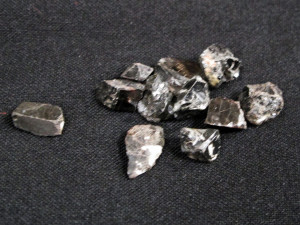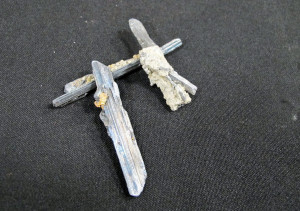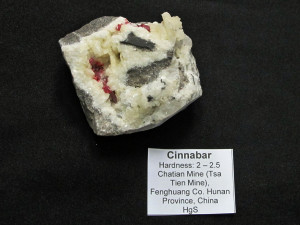Many children are crazy about minerals now because of their passion for the online game, Minecraft. But do they realise that we are absolutely surrounded by minerals in our daily lives? Aside from forming the beautiful crystals that we marvel at, minerals are actually incredibly important to modern life. Minerals ores are mined and used as for the useful elements and chemical they contain. They are processed and used for practical applications, without which life would be very different! This is why minerals are valued and mined. They are so important in our daily lives that we thought you might like to know a bit about the raw minerals. Here is a blog about what they look like and what they are used for after processing. As you may already know. Hope it helps with homework by the way!
If this was enough for you and you’d rather go shopping bail out here... otherwise, here’s our list of minerals and their uses:
Minerals and their uses: Sphalerite
Sphalerite is used in Zinc for galvanising. It is used in making brass and bronze and for zinc alloys. Zinc is used to galvanise and protect iron and steel because it reacts with atmospheric oxygen. It forms zinc oxide which then reacts with atmospheric carbon dioxide to form zinc carbonate. This is then effective against corrosion.
Minerals and their uses: Cassiterite
Cassiterite produces Tin, which is is used in alloys for solder. This is because it is relatively soft and easily pulled and stretched into a thin wire. Tin has an oxide film which protects it from corrosion and is therefore used a plating on other metals to prevent harmful and unwanted corrosion.
Minerals and their uses: Molybdenite
Molybdenum is added to steel to create very strong alloys. When added to steel in concentrations between 0.25% and 8%, molybdenum forms high strength steels. They can withstand pressures up to 210,000 tons per square meter! Hence used in car parts and construction.
Minerals and their uses: Stibnite
Stibnite, when processed, gives us Antimony. This is used with mainly lead to make alloys which helps material to flow in the production of castings, e.g. glass and metals. The material flows much easier compared to using pure lead. Antimony can also add strength and rigidity to structural designs. Used in medicine, glass making, fireworks and solder.
Minerals and their uses: Baryte
Barium is used in drinks or ‘barium milkshakes’ in radiotherapy and X-rays. Barium coats the inside of the body and absorbs X-rays. This allows the size and shape of the internal organs to be clearly visible. They appear white on X-rays. It is also used for ink and plastic products.
Minerals and their uses: Bauxite
Bauxite produces Aluminium, which is used, amongst other things, for cans for drinks and food because it is lightweight, easily pressed into a desired shape and doesn’t interfere with taste in the way other metals would. Fancy keeping your sandwiches in it? Also used in wire, cars ….
Minerals and their uses: Beryl
Perhaps one of the most known types of Beryl is sought-after Aquamarine. Beryllium is used in fluorescent lamps and in aircraft alloys because it is very light and has a high melting point. Beryllium metal is also used in the making of springs and gears because it is elastic.
Minerals and their uses: Rutile
Such a pretty inclusion, often found in quartz. Once processed, it produces Titanium, famously used in aerospace applications and armour because of its lightness and strength. Titanium and titanium alloys are used in airframe structures such as wings and landing gears. They are used because they are resistant to corrosion. They are very strong but also lightweight. Therefore they are and are suitable for thermal expansion. Used also in chemical processing.
Minerals and their uses: Galena
Lead is used in radiation proctection because it is very dense and has a large number of electrons. These properties allow lead to scatter harmful X-rays and gamma-rays. This reduces their potential for serious harm. Without a lead shield our DNA can be affected, causing cancers. Also used in lead-acid batteries.
Minerals and their uses: Cobaltite
Cobaltite is processed into Cobalt and used in magnets and for jet turbines and engines. Even at high temperatures it is very resistant to corrosion. So now you know.
Minerals and their uses: Hematite
We love the appearance of this one, all characteristic silvery bubbles and red powder. Like many minerals it is strangely fascinating! Hematite is transformed into Iron. It is then used in building and construction especially for large structures like ships. This is because it is strong, widely available and cheap. Advancements have meant that rusting can be reduced or prevented.
Minerals and their uses: Spodumene/Lepidolite
Lithium ions are used in batteries because of their low density and ability to store a lot of electricity. Lithium is also used in Vitamin A production. Enjoy your daily dose – or you prefer to stick to carrots?
Minerals and their uses: Cinnabar
Cinnabar becomes transformed into Mercur. It is used in thermometers because it is liquid at room temperature and it has a high level of thermal expansion so even small temperature changes are noticeable.
Minerals and their uses: Quartz
Silica combined with carbon forms the very hard silicon carbide which is very effective as an abrasive. Silicon is a metalloid. This means that it has both metal and non-metal properties. I t is used in computer chips because it conducts electricity but does not conduct heat very well. It has a high melting point so the computer doesn’t melt or overheat. Also used in pressure gauges and glass. abrasives.
Minerals and their uses: Halite/Rock Salt
Sodium and salt are used for curing meats and preserving other foods. Most bacteria, fungi and moulds cannot survive in a salty environment. This is because of the osmotic gradient salt creates which is what causes the bacteria etc to become dehydrated and unable to function. Throat a bit sore? A salt gargle for you then and avoid catching that cold!
Minerals and their uses: Fluorite
Fluoride is an active ingredient in toothpaste. It is used because it improves the quality of enamel making it more acid resistant. It reduces the ability of plaque bacteria to produce acid to attack the teeth. Fluorite also gives us hydrofluoric acid, which is used in pottery and ceramics.
Minerals and their uses: Calcium
Calcium carbonate is a fundamental ingredient in the making of cement. Cement is made by heating powdered limestone (calcium carbonate) with clay. Water, sand and crushed rock is added to make concrete or just water and sand to make mortar used in brick laying.
Minerals and their uses: Scheelite
Sheelite gives us Tungsten. This is used for wire and filaments in bulbs because it has a high melting point. A filament in a bulb needs to conduct electricity but also not melt under the heat which the electricity causes.
If you want to be amazed by how much or many minerals we use, check this link by USGS
Well, we hope you enjoyed that little tour and if you want to see some of these rocks in their rough or processed decorative form check out some of the beauties in our Fossil and Crystal Shop .Com Or here are more informative blogs about geology.
Thanks for dropping by!



















